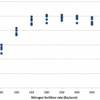Abstract
Fertilizer recommendations contain several important factors, including fertilizer form, source, application timing, placement, and irrigation management. Another important part of a fertilizer recommendation is the amount of a particular nutrient to apply. The optimum fertilizer amount is determined from extensive field experimentation conducted for several years, at multiple locations, with several varieties, etc. This 10-page fact sheet focuses on the research principles behind determining the optimum rate of fertilizer, including experimentation and interpreting research results for optimum crop production and quality in conjunction with minimal environmental consequences. Authors George Hochmuth, Ed Hanlon, and Allen Overman use examples from research with vegetable crops in Florida and emphasize that how one interprets the results is as important as how one conducts the research. Published by the UF Department of Soil and Water Science, October 2011.
References
Black, C. A. 1992. Soil Fertility Evaluation and Control. Boca Raton, FL: Lewis Publishers.
Bullock, D. G., and D. S. Bullock. 1994. "Quadratic and Quadratic-plus-plateau Models for Predicting Optimal Nitrogen Rate of Corn: A Comparison." Agron. J. 86:191-5. https://doi.org/10.2134/agronj1994.00021962008600010033x
Cerrato, M. E., and A. M. Blackmer. 1987. "Comparison of Models for Describing Corn Yield Response to Nitrogen Fertilizer." Agron. J. 82:138-43. https://doi.org/10.2134/agronj1990.00021962008200010030x
Dahnke, W. C., and R. A. Olson. 1990. "Soil Test Correlation, Calibration, and Recommendation." In Soil Testing and Plant Analysis, 3rd edition, edited by R. L. Westerman, 45-71. Madison, WI: Soil Sci. Soc. Amer. https://doi.org/10.2136/sssabookser3.3ed.c4
Hochmuth, G. J., E. E. Albregts, C. C. Chandler, J. Cornell, and J. Harrison. 1996. "Nitrogen Fertigation Requirements of Drip-irrigated Strawberries." J. Amer. Soc. Hort. Sci. 121:660-5. https://doi.org/10.21273/JASHS.121.4.660
Hochmuth, G. J., J. K. Brecht, and M. J. Bassett. 1999. "N Fertilization to Maximize Carrot Yield and Quality on a Sandy Soil." HortScience 34(4): 641-5. https://doi.org/10.21273/HORTSCI.34.4.641
Hochmuth, G. J., J. Brecht, and M. J. Bassett. 2006. "Fresh-Market Carrot Yield and Quality Responses to K Fertilization of a Sandy Soil Validated by Mehlich-1 Soil Test." HortTechnology 16:270-6. https://doi.org/10.21273/HORTTECH.16.2.0270
Hochmuth, G. J., and E. A. Hanlon. 2010a. Principles of Sound Fertilizer Recommendations. SL315. Gainesville: University of Florida Institute of Food and Agricultural Sciences. http://edis.ifas.ufl.edu/ss527. https://doi.org/10.32473/edis-ss527-2010
Hochmuth, G. J., and E. A. Hanlon. 2010b. Summary of N, P, and K Research with Watermelon in Florida. SL325. Gainesville: University of Florida Institute of Food and Agricultural Sciences. http://edis.ifas.ufl.edu/cv232. https://doi.org/10.32473/edis-cv232-2010
Hochmuth, G. J., E. A. Hanlon, and J. Cornell. 1993a. "Watermelon Phosphorus Requirements in Soils with Low Mehlich-1 Extractable Phosphorus." HortScience 28:630-2. https://doi.org/10.21273/HORTSCI.28.6.630
Hochmuth, G. J., R. C. Hochmuth, M. E. Donley, and E. A. Hanlon. 1993b. "Eggplant Yield in Response to Potassium Fertilization on Sandy Soil." HortScience 28:1002-5. https://doi.org/10.21273/HORTSCI.28.10.1002
Nelson, L. A., and R. L. Anderson. 1977. "Partitioning of Soil-test Response Probability." In Soil Testing: Correlation and Interpreting the Analytical Results, spec. publ. 29, edited by T.R. Peck, J.T. Cope, and D.A. Whitney, 19-38. Madison, WI: Am. Soc. Agron. https://doi.org/10.2134/asaspecpub29.c2
Overman, A. R., F. G. Martin, and S. R. Wilkinson. 1990. "A Logistic Equation for Yield Response of Forage Grass to Nitrogen." Commun. Soil. Sci. Plant Anal. 21:595-609. https://doi.org/10.1080/00103629009368255
Overman, A. R., M. A. Sanderson, and R. M. Jones. 1993. "Logistic Response of Bermudagrass and Bunchgrass Cultivars to Applied Nitrogen." Agron. J. 85:541-5. https://doi.org/10.2134/agronj1993.00021962008500030004x
Overman, A. R., and S. R. Wilkinson. 1992. "Model Evaluation for Perennial Grasses in the Southern United States." Agron. J. 84:523-9. https://doi.org/10.2134/agronj1992.00021962008400030031x
Willcutts, J. F., A. R. Overman, G. J. Hochmuth, D. J. Cantliffe, and P. Soundy. 1998. "A Comparison of Three Mathematical Models of Response to Applied Nitrogen: A Case Study Using Lettuce." HortScience 33:833-6. https://doi.org/10.21273/HORTSCI.33.5.833

